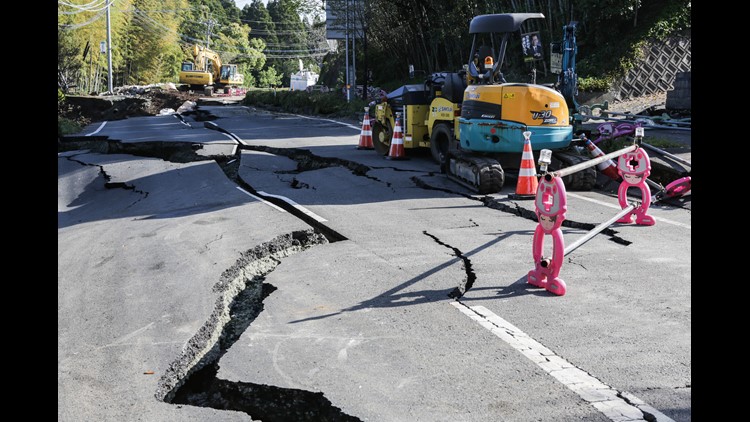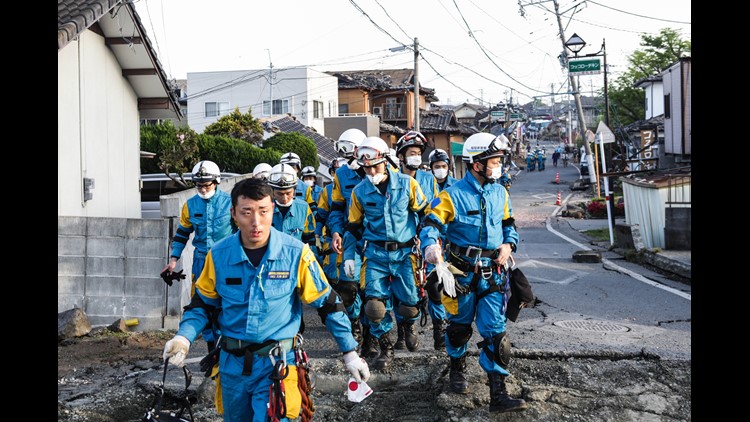TOKYO – Continuing aftershocks and the threat of heavy rain and wind added urgency to rescue efforts Saturday as authorities raced to help victims of two powerful earthquakes that struck southwestern Japan.
At least 29 people have been killed and some 1,500 injured in the two quakes that struck Kumamoto Prefecture late Thursday and early Saturday, according to Japan’s Kyodo News Service.
Many victims are feared trapped in collapsed homes and buildings, particularly in towns and villages cut off by downed bridges or landslides that have blocked key roads and highways.
The national government has dispatched 20,000 troops – many trained especially for disaster relief operations – to join thousands of local police, firefighters and rescue workers.
An approaching storm system was expected to arrive in the area late Saturday, prompting the government to rush additional rescue workers to the area, along with thousands of water-proof tarps to protect victims and workers.
Authorities fear that heavy rain could trigger additional landslides in the mountainous region.
“Daytime today is the big test” for rescuers, Prime Minister Shinzo Abe said at the outset of an emergency meeting in Tokyo on Saturday. Abe said he had planned to travel to the stricken area on Saturday but canceled plans so as not to impede rescue operations on the ground.
Chief Cabinet Secretary Yoshihide Suga told a press conference Saturday that workers are aware of multiple locations where victims “have been buried alive.”
“Police, firefighters and Self Defense Force personnel are doing all they can to rescue them,” Suga said. He said about 70,000 people have sought shelter in emergency centers.
PHOTOS | Massive earthquake rocks SW Japan
Massive earthquake rocks SW Japan
Kyodo News reported that police had received 97 reports of people trapped or buried under collapsed buildings, while ten people were caught in landslides.
Aftershocks continued to hit the area on Saturday, rattling damaged structures and interrupting rescue operations.
The Japan Earthquake Research Committee reported that 252 smaller quakes or aftershocks had hit the area by 11 a.m. Saturday.
A magnitude-6.5 earthquake struck the Kumamoto region at about 9:26 p.m., local time, Thursday, and was followed by an even larger magnitude-7.3 quake at about 1:25 a.m. Saturday.
Both quakes were centered in Kumamoto Prefecture on the island of Kyushu, one of the country's four main islands.
Kumamoto is a largely rural, mountainous region and is less densely populated than much of Japan. Some older homes and structures lack modern earthquake-mitigation technology found elsewhere in the country and therefore are likely more vulnerable to powerful quakes.
Officials from the Japan Meteorological Agency said Saturday’s quake was believed to be the “main quake” following a series of “precursor” events.
A huge landslide swept away homes and severed a major highway near the town of Minami-Aso, and a large bridge was knocked from its foundations.
In Kumamoto City, a 500-bed municipal hospital was one of several buildings nearly demolished by the quake and officials were evacuating patients, according to the national broadcaster NHK.
Kyodo News Service reported that that some 120,000 homes in the region were without electricity. Drinking water systems had also failed in the area.
Kyodo News Service reported that that some 120,000 homes in the region were without electricity. Drinking water systems had also failed in the area.
Suga said 1,600 members of the Japan Self Defense Force had joined the rescue efforts and Defense Minister Gen Nakatani told reporters that a total of 20,000 troops would be deployed to the area over the weekend.
About 50,000 U.S. troops are based in Japan, though none in the Kumamoto region. A spokesperson for the U.S. Embassy in Tokyo said that the Japanese government so far has not requested help.
"We offer our condolences for those affected by the earthquakes in Kumamoto. The U.S. government is ready to offer support if and when needed,” said spokesperson Marrie Schaefer.
NHK showed video of stones tumbling from the walls of historic Kumamoto Castle, and a wooden structure in the complex was smashed.
A bright spot, broadcast repeatedly on television Friday, was the overnight rescue of an apparently uninjured baby, wrapped in a blanket and carried out of the rubble of a home.
Contributing: The Associated Press

















